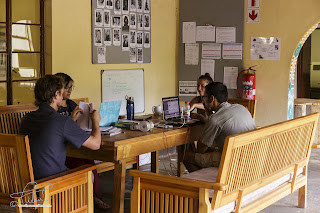 |
| african wild dogs |
So four weeks pass really quick, especially if your eager and zealous on making your impact everyday. If you carry out voluntary work in different sectors, having a packed day, in addition not wasting any spare time with unnecessery things and if you head to the physical limits. Besides you´re doing your usual thing with the photography, like the photo editing. And after all you won´t find a lot of time to sleep. This may sound like a horror trip for some people. For me, this is the perfect off work adventure. And so, this time it was a pretty incredible experiance again, but super exhausting as well.
The average daily routine started with getting up early, mostly around 5 o'clock. To be on time for the awakening of the wildlife in one of the three nature reserves, or to be able to finish the physical tasks before lunch time. The time until noon was usually packed with project work or lectures about diffrent topics.
 |
| the bush |
At lunchtime we were given an hour to relax, so the early afternoon was available for further project work or preparations for the activities of the next few days. In the late afternoon or early evening we went back to the reserves to collect more data and to observe the wildlife. After the dinner prepared for us in the lounge, we played cards or table tennis, edited photos or chatted about the experience of the day.
 |
| hyenas at a kill |
A brief overview of the tasks:
- Research:
 |
| working tasks |
- Project work:
 |
| project work |
- Conservation:
 |
| river thorne clearing |
In terms of conservation and the preservation of the habitat we were active mainly in one of the reserves and near our lodge. In order to prevent large forest fires, a fire protection corridor must be created and maintained between the nature reserves and the affected areas. That means removing thorny shrubs and dead trees. With even more thorns we had to deal with the clearing of non-native large river thorn bushes, which among other things loop around existing trees and thus destroy the vegetation. Pretty nasty. But also a lot of fun. The usual 3% loss was then a torn T-shirt, holey shorts and lots of small cracks and scratches all over. Physically more pleasant was the removal of animal traps and snare weeps. However, small wire loops attached to fences are not so easy to spot when checking the fences over the area for several kilometers, yet it requires some concentration. We have found some, which is good on the one hand, that they are no longer usable, but on the other hand shows that poaching on small mammals with effective traps is unfortunately still ongoing. And last but not least, searching for broken fences around the reserves had been on the to do list. Again, a high concentration was required to detect and recognize small holes in or below the fence line.
- Social:
 |
| reading club |
 |
| leopard on a marula tree |
Too lazy for reading or want to see more?
Check out my two videos ...
... for interesting wildlife encounters
... for some snippets about the project
And the best of collection of photos:
www.snowmanstudios.de
And if you want to see some more photographs with an informative description, check out the ebook version of the coffee table book "Wildlife and Landscape - the African Impact".
I hope you´ll enjoy it.
Project information: Leopard and Predator Research Project by African Impact, a volunteer organization operating throughout Africa. The project fee, which is paid by us volunteers to support the projects, will be used to fund the ongoing development of additional programs and will allow for further projects and donations through the African Impact Foundation and ALERT.
Go go go volunteering!
 |
| big ones |
 |
| small ones |
Kommentare
Kommentar veröffentlichen